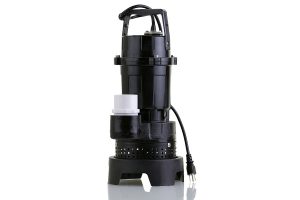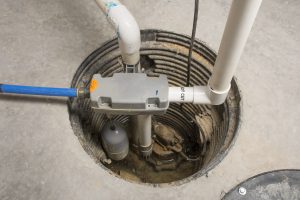 Heavy rains, melting ice, or just a pipe that’s burst after a cold snap can all lead to the same thing: A flooded basement. When the lowest point of your home floods, many things suffer. Carpets and walls are damaged and may need to be replaced. Timbers can warp after a flood and mold begins to grow and spread. Water that leaks into the surrounding ground will find its way into your foundation where it eventually leads to a cracked foundation as the ground becomes uneven or the water freezes. A sump pump is an important tool for keeping your basement from flooding and preventing future problems.
Heavy rains, melting ice, or just a pipe that’s burst after a cold snap can all lead to the same thing: A flooded basement. When the lowest point of your home floods, many things suffer. Carpets and walls are damaged and may need to be replaced. Timbers can warp after a flood and mold begins to grow and spread. Water that leaks into the surrounding ground will find its way into your foundation where it eventually leads to a cracked foundation as the ground becomes uneven or the water freezes. A sump pump is an important tool for keeping your basement from flooding and preventing future problems.
What is a Sump Pump?

A motorized water pump located at the lowest point of your home (typically a basement, cellar, or crawl space). By placing this pump in the lowest point, water will collect there first. This submersible pump is activated by heightened water levels caused by flooding. As soon as the pump is submerged (or the pump’s sensor detects pooling water) it activates and begins pushing water out of your home.
If you’re looking to install a sump pump in your home, here are a few things to keep in mind:
- Submersible pumps are easily hidden, since the pump itself rests inside the well. That will make it a little more difficult to maintain in the future, but it does give you a little extra space in your basement.
- The return flow should be direct away from your home. Older pumps fed directly into city sewers but this practice is no longer ideal (if you have an older sump pump, check with your plumber to see if it leads to the sewer, you may need to update) since it can lead to backed up sewer systems during heavy rainfall.
- A manual sump pump is usually cheaper, but it won’t activate unless someone turns it on. Sump pumps are a type of emergency flood device, so it’s usually worth it to pay the extra for an automatic pump.
How to Test a Sump Pump
Testing a pump is very simple. Get a gallon of water (either fill a gallon water bottle or a bucket with about a gallon) and pour it into the pump well in your basement or cellar. Have someone standing outside where the outflow pipe is to monitor flow there when you do this.

If your pump is manual, once the well is full turn on the pump and wait until the water is removed. If the pump is in working order, the water will be removed from the well and the outflow pipe will direct water away from your house (you don’t want it pooling against your home again). If the pump doesn’t engage, check the breaker circuit to make sure the pump has power.
For automatic pumps, as soon as you pour the water in the pump should engage almost immediately. If it doesn’t, check the float valve or pressure switch to make sure that there is enough water in the basin to trigger the pump. If there is, double check the circuit breaker to make sure the pump is receiving power.
If your sump pump isn’t working, get it fixed immediately! Rain storms can be sudden events and getting a maintenance technician to repair your pump mid-storm is a bad idea. You don’t want to be caught with a flooded basement during a heavy storm.
Don’t forget to follow RestoPros on Facebook, Twitter, LinkedIn, and Google+ for new Updates, News, and Discounts
